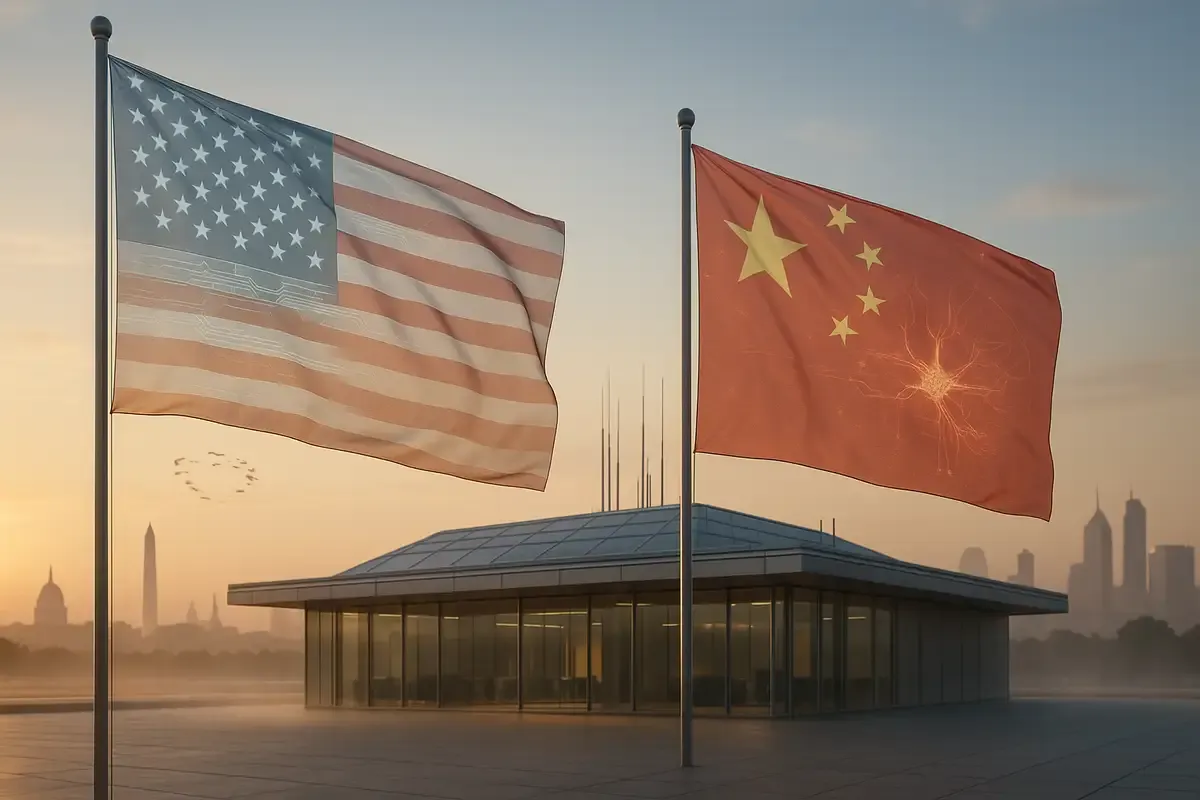💡 TL;DR - The 30 Seconds Version
🏳️ Trump administration reverses chip ban in July 2025, approving Nvidia H20 and AMD MI308 sales to China after containment strategy backfires.
💰 China pours $98 billion into AI in 2025 (48% jump), with $56 billion from government—50x more than U.S. federal AI spending.
🚀 DeepSeek stuns Silicon Valley by matching OpenAI's GPT-4 performance for just $6 million, proving efficiency beats brute-force compute.
📊 Performance gap shrinks to 0.3% between U.S. and Chinese AI models, with China's open-source strategy threatening Western business models.
⚖️ Despite progress, China faces critical weaknesses: 73% chip efficiency vs. Nvidia, $109B vs. $9.3B private investment gap, and 25% vs. 50% senior talent.
🌍 AI competition enters "managed interdependence" phase—neither country can dominate through technology alone, changing the rules of tech supremacy.
On July 15, Nvidia CEO Jensen Huang appeared on Chinese state television during the China International Supply Chain Expo in Beijing. “Half of the world’s AI researchers are in China,” he said. “And now, they’re building world-class models.” Huang had just secured U.S. government approval to resume chip exports to China. Live on CCTV, the American tech titan praised the very ecosystem Washington had spent years trying to choke.
The message was unmistakable: China had arrived.
Days earlier, the Trump administration reversed course on its signature AI containment strategy. After months of choking China’s access to cutting-edge chips, Washington approved sales of Nvidia’s H20 and AMD’s MI308 processors to Chinese firms. The decision sent tech stocks soaring—and marked a quiet admission that the chip war had failed.
The shift followed a blunt conversation between Huang and the president. Nvidia had lost $5.5 billion in projected revenue due to the export restrictions. Worse, Chinese engineers were adapting. They were building efficient AI systems that didn’t need the world’s best chips. They shared code. They backed domestic fabs. Washington’s weapon misfired.
And in that vacuum, China surged forward.
Follow the Money
Beijing’s AI rise isn’t an accident. It’s an industrial campaign fueled by a firehose of state spending. In 2025 alone, China will pour $98 billion into AI development—a staggering 48% jump from last year. Over half—$56 billion—comes directly from government coffers. That’s more than 50 times what the U.S. federal government spends annually on AI R&D.
The money flows through a complex web of channels. In January, China launched its National AI Industry Investment Fund, seeding startups with $8.2 billion. Shanghai countered with a $14 billion fund. Beijing’s municipal government pledged $7 billion. State banks joined the charge: the Bank of China committed $138 billion in long-term AI financing over five years.
But this isn’t scattershot spending. It’s a calculated push built on three pillars: infrastructure, talent, and deployment.
The infrastructure story starts with geography. China’s “Eastern Data, Western Compute” initiative is building eight national supercomputing hubs in interior regions where electricity is cheap. The goal: link data-rich eastern cities with compute-rich western provinces via high-speed optical networks.
By the end of 2025, China will hit 300 exaFLOPS of AI computing capacity. That still trails America—but the gap is narrowing fast.
Meanwhile, 20 “AI Pilot Zones” let startups experiment with minimal red tape. These zones offer “compute vouchers”—free GPU time—to lower training costs. Local governments sweeten the deal with tax breaks, fast permits, and subsidized office space. Industrial policy, meet startup culture.
New Champions, Old Titans
Forget the bureaucrats. The face of China’s AI surge is Liang Wenfeng—a hedge fund quant turned tech disruptor.
In January, his company DeepSeek released a model called R1 that stunned the global tech community. It matched the performance of OpenAI’s GPT-4—and did it on a $6 million training budget. OpenAI reportedly spent hundreds of millions.
The secret? Ruthless efficiency. DeepSeek’s model doesn’t fully “wake up” for every query. Only relevant parts activate, cutting power use by 90%. The architecture—Mixture of Experts at scale—was novel and highly optimized. Then they did something bold: they gave it away.
DeepSeek open-sourced the code. Any developer can download it, study it, and improve it. And many are doing just that.
The result was a shockwave. American tech stocks lost more than $1 trillion in market value in the weeks after R1’s release, as investors recalibrated expectations. China wasn’t lagging. It was leapfrogging.
Beijing noticed. Liang was invited to a closed-door meeting with Premier Li Qiang the day of the launch. Officials praised DeepSeek’s alignment with national priorities. Then came the funding. DeepSeek now receives infrastructure support from both city and state governments. It is the new national champion—and the signal to others was clear: efficiency, open code, and mission alignment get rewarded.
The giants responded. Alibaba pledged $52 billion in new AI investments over three years. Its Qwen model series now ranks among the world’s best on standard benchmarks. Baidu’s Ernie Bot hit 200 million users. Tencent rolled out generative AI across games and social platforms and seeded capital into a dozen AI startups.
The startup ecosystem followed suit. Zhipu AI, backed by $140 million from Shanghai’s government, filed IPO papers in July. Moonshot AI, whose chatbot “Kimi” excels at long-document analysis, released its open-source model days after DeepSeek. Minimax, another contender, trained a frontier model using just 512 Nvidia GPUs—a fraction of the compute typical in the West.
Huawei plays a different but crucial role. Sanctioned, isolated, and forced to go it alone, it built a parallel stack—hardware, software, developer tools. Its Ascend chips still lag Nvidia in performance but now power dozens of Chinese AI deployments. Government cloud contracts are steering traffic toward Huawei’s stack.
Beijing’s Open-Source Weapon
Since June 2025, Chinese firms have embraced open-source AI with strategic clarity. The country’s best models—R1, Kimi K2, and Qwen—are freely available. The code, the weights, the architecture—all online.
It’s not altruism. It’s asymmetry.
Open source transforms hardware disadvantage into software advantage. Developers around the world can adapt Chinese models to run on whatever chips they have—including Huawei’s. A global swarm of engineers is now working, unpaid, to improve China’s AI.
It also builds soft power. When a French or Brazilian startup builds on DeepSeek’s models, it becomes invested in China’s ecosystem. Familiarity breeds influence.
There’s a market disruption, too. While OpenAI and Anthropic charge premiums for access, Chinese models are free. That pressures American firms to cut prices—and threatens their ability to recoup R&D.
But it’s risky. Giving away crown jewels makes reverse engineering easy. Western companies now study and adapt China’s architecture. Monetization becomes harder, too. If the model is free, you have to compete on cloud services—and that’s a battlefield where Amazon and Microsoft dominate.
Still, the calculus in Beijing is clear: Better to win share and global usage now than guard secrets and fall behind.
China Nears AI Parity
The latest Stanford AI Index paints a stark picture. The performance gap between American and Chinese frontier models has shrunk to just 0.3% on key benchmarks.
In math reasoning and general knowledge, Chinese models now match GPT-4. In some domains, they lead. Moonshot’s Kimi K2 scores 65.8% on real-world programming problems. GPT-4 clocks in at 54.6%.
Deployment is exploding. Baidu’s robotaxis have logged 50 million autonomous kilometers. Banks use AI for fraud detection. Cities deploy it for traffic optimization. One viral app helps users diagnose hair loss using image recognition. AI has gone mainstream—and not just in labs.
This scale gives China an edge. More users mean more data. More data means better models. Bugs surface and get patched. Edge cases become training fodder. The feedback loop tightens. It’s a flywheel effect America can’t easily replicate—especially if regulatory pressure slows down mass deployment in the West.
The Weak Links
Still, China’s rise has limits—and some are structural.
The biggest: compute. Even with H20 chip sales resuming, China’s access is restricted. It gets only export-compliant models—less powerful, less efficient. Huawei’s top chip, Ascend 910B, reaches just 73% of the performance of Nvidia’s A800. That means more chips, more power, and more space to train the same model.
Private capital is another bottleneck. U.S. venture funds invested $109 billion in AI in 2024. China’s figure? $9.3 billion. That’s a 12-to-1 gap. In America, startups are free to fail fast and swing big. In China, survival often depends on staying in sync with state goals.
Talent is uneven, too. Half of U.S. AI researchers have more than a decade of experience. In China, it’s just 25%. Experience matters—especially for foundational breakthroughs.
Then there’s governance. China’s AI firms operate at the pleasure of the state. Regulations can shift overnight. Data access rules change monthly. A successful product today could be banned tomorrow. The fear of arbitrary clampdowns haunts even the best-funded players.
And while the state can pick winners, it can also pick wrong. Betting big on the wrong architecture—or the wrong company—risks sinking billions into dead ends. Centralized risk is efficient, but brittle.
This is no longer just a tech rivalry. It’s a contest of systems. The U.S. approach remains decentralized, venture-funded, and high-risk. China’s is top-down, industrial, and all-in. For years, Washington assumed its model would win by default. That assumption no longer holds.
Stanford’s Fei-Fei Li put it bluntly:
“This isn’t catch-up. It’s rerouting the entire race.”
Even Nvidia—long a symbol of American tech dominance—now plays both sides. The chip ban failed. The U.S. blinked. China built workarounds.
And perhaps most importantly: you no longer need the best chips to build the best AI. DeepSeek proved that smart design beats raw horsepower. That insight reshuffles the global AI map. It opens the door to smaller nations, leaner firms, and alternative alliances.
Neither side can win outright. But both can lose—if they underestimate the other. As of mid-2025, Beijing is betting big, moving fast, and setting the terms of engagement. Washington, once dominant, now plays catch-up in strategy—even if it still leads in silicon.
The future of AI won’t be decided in boardrooms or labs alone. It will be written in deployment logs, energy grids, training runtimes—and in the quiet recalibrations of policymakers who now realize: the race is real, the clock is ticking, and the outcome is wide open.
❓ Frequently Asked Questions
Q: What are H20 chips and why did the U.S. ban them?
A: The H20 is Nvidia's weakened AI chip designed for China. It has about 75% of the performance of Nvidia's top chips. The U.S. initially banned all advanced AI chip exports to slow China's military AI development, but reversed course when China started building competitive AI without them.
Q: How much does it normally cost to train a top AI model?
A: Training GPT-4 class models typically costs $100-500 million. DeepSeek shocked the industry by achieving similar performance for just $6 million using efficiency techniques. Most Western AI labs spend hundreds of millions on compute alone, not counting researcher salaries and infrastructure.
Q: What is the "mixture of experts" technique DeepSeek used?
A: It's like having specialist teams that only activate when needed. Instead of using the entire AI model for every task, only relevant sections "wake up." This cuts power use by 90% while maintaining performance. Think of it as lights that turn on only in rooms you're using.
Q: What are "compute vouchers" and how do they work?
A: They're government-issued coupons for free GPU time at data centers. Chinese startups in AI Pilot Zones get these vouchers to offset the high cost of training AI models. It's like food stamps but for computing power—helping cash-strapped startups compete with bigger players.
Q: How powerful is 300 exaFLOPS of computing?
A: That's 300 quintillion calculations per second—enough to simulate complex weather patterns or train multiple large AI models simultaneously. For context, the world's fastest supercomputer in 2023 had 1.2 exaFLOPS. China's 300 exaFLOPS represents about 15% of global AI compute capacity.
Q: Why does open-sourcing AI models hurt American companies?
A: OpenAI charges $20/month for ChatGPT access. When Chinese companies release equally good models for free, users switch. This destroys pricing power and makes it hard to recover the billions invested in development. It's like competing with someone giving away what you're trying to sell.
Q: What's the difference between Huawei's Ascend chips and Nvidia's?
A: Huawei's best Ascend 910B chip reaches 73% of the performance of Nvidia's export-compliant A800 (which itself is weaker than Nvidia's best). Chinese companies need 1.4x more Ascend chips to match Nvidia's power, making their data centers larger and more expensive to run.
Q: Which Chinese AI companies should I know about?
A: DeepSeek (efficiency breakthrough), Zhipu AI (heading for IPO), Moonshot AI (Kimi chatbot, beats GPT-4 at coding), Minimax (frontier performance on 512 GPUs), plus giants like Alibaba (Qwen models), Baidu (Ernie Bot, 200M users), and Huawei (Ascend chips).
Q: How does China's AI investment compare to previous tech pushes?
A: It's bigger and faster. China spent $75 billion over 10 years to dominate solar panels. The $98 billion for AI in 2025 alone dwarfs that. Unlike manufacturing, AI requires continuous innovation, making this push riskier but potentially more transformative.
Q: What happens next in the U.S.-China AI competition?
A: Both sides are locked in "managed competition." The U.S. will keep selling older chips while protecting its newest technology. China will push for complete self-reliance by 2030. Expect more breakthroughs from both sides, with the real battle shifting from raw compute to deployment at scale.








